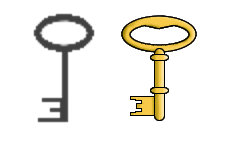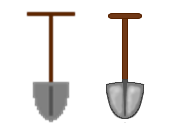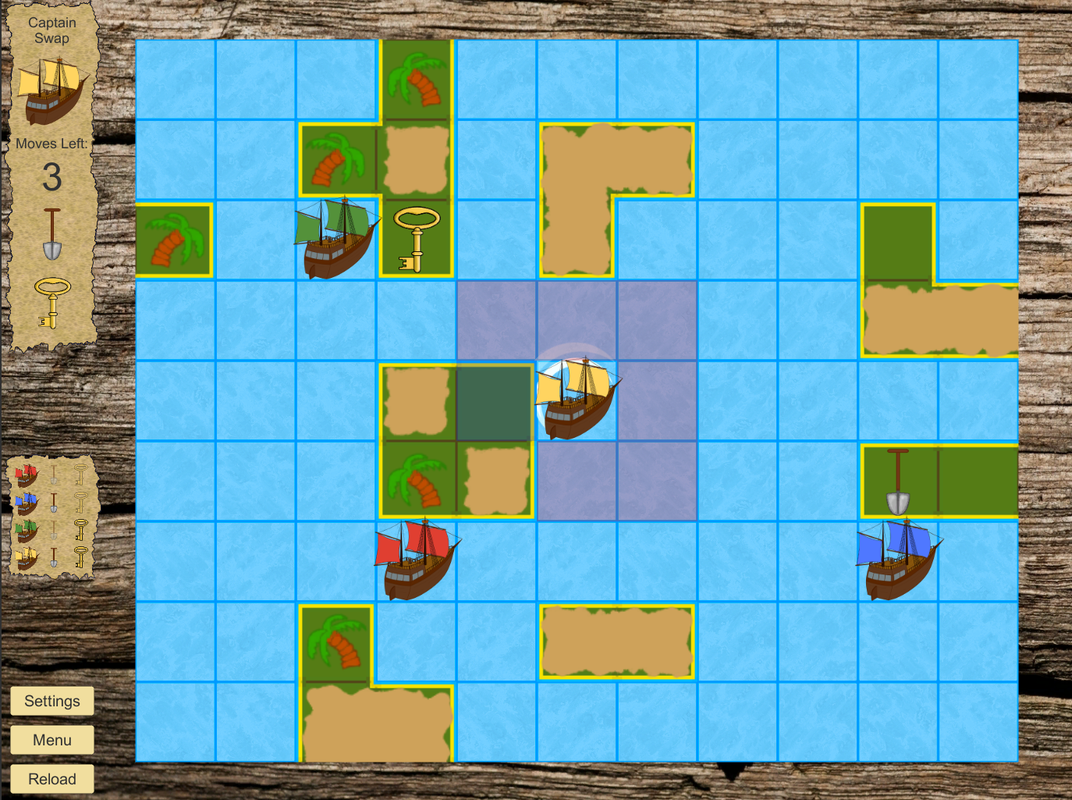Another week, another update on Key, Shovel, Treasure. Slowly but certainly, I'm getting the hang of this graphics stuff. The upshot of that is that I have things to show :). Here are the new versions for the key and the shovel:
And here is how they look in the game:
I also updated the menu for team play. You could choose between teams 1 and 2, but those numbers mean nothing in game. So I changed the numbers to the I cons I've also used on the sails: a skull and a set of cutlasses. So the menu now looks like this when teamplay is toggled on:
I think this is much clearer than using numbers. And the icons make sure that the selection here is linked to what you see in the game.
I've also fixed a transparency issue in the menu. It helps for clarity if the menu items for players who are not in the game are transparent and non-interactable. And the same goes for the team selection elements if teamplay isn't on. When I first put that in the game, I used a hack by simply covering those menu items with a semi-transparent image of the same colour as the menu background. But that no longer worked after I created parchment for the background.
So I set about trying to find a way to actually set the alpha of the menu items. Turns out that you can loop over all the children of a game object, which looked promising. Not having to separately set the alpha for every individual menu item sounds good to me. But then I ran into the problem that accessing the alpha works differently for the various types of menu items like texts, buttons and images. Which meant more work than I'd hoped.
And then I found out about Canvas Groups. Which do exactly what I wanted. You can use them to set both the alpha and interactability of a menu item and all its children. I guess the lesson here is Google first, code later :).
I've also fixed a transparency issue in the menu. It helps for clarity if the menu items for players who are not in the game are transparent and non-interactable. And the same goes for the team selection elements if teamplay isn't on. When I first put that in the game, I used a hack by simply covering those menu items with a semi-transparent image of the same colour as the menu background. But that no longer worked after I created parchment for the background.
So I set about trying to find a way to actually set the alpha of the menu items. Turns out that you can loop over all the children of a game object, which looked promising. Not having to separately set the alpha for every individual menu item sounds good to me. But then I ran into the problem that accessing the alpha works differently for the various types of menu items like texts, buttons and images. Which meant more work than I'd hoped.
And then I found out about Canvas Groups. Which do exactly what I wanted. You can use them to set both the alpha and interactability of a menu item and all its children. I guess the lesson here is Google first, code later :).
One thing that Michiel has been commenting on project-wise is that hitting the play button from the game scene in the editor doesn't start the game properly. So testing always involves switching back to the menu scene before starting. Today, my own annoyance at having to switch back finally got to the level that solving this moved to the top of my list of priorities. After some (more) Googling, I found a great solution for exactly this thing on Unity Answers.
Turns out you can add menu items to the editor by placing a script in a folder named "Editor" in your project. And the script that you need for this is really simple, courtesy of the people who put in the time to figure this out. You can find the relevant thread here. This may just become a standard addition to my Unity projects.
Turns out you can add menu items to the editor by placing a script in a folder named "Editor" in your project. And the script that you need for this is really simple, courtesy of the people who put in the time to figure this out. You can find the relevant thread here. This may just become a standard addition to my Unity projects.
Last but not least, something about Powargrid (and yes, I couldn't resist using KSP as a title for this post). It's been a while since we've said anything about Powargrid, but we certainly haven't forgotten about it. As we've said before, we're running Wee Free Studio next to our day jobs (and our family lives of course), so the time we can invest is limited. But having said that, we're still working on the next Powargrid update.
The main part of this update will consist of a number (we're not yet sure how many) of missions that can be played independently from the campaign. We're calling them Challenge Missions, since they're supposed to be a challenge for players who have finished the campaign. But they will have an easy setting if that's more to your liking. And a hard setting for if you're feeling particularly masochistic.
These mission will have dialogues, just like the campaign, but no overarching story line. So the order in which you play these missions won't matter. Story-wise these missions are set after the campaign. Having said that, we're do try to keep the spoilers to a minimum.
Speaking of which, here is a screenshot of one of the challenge missions (obviously a work in progress):
The main part of this update will consist of a number (we're not yet sure how many) of missions that can be played independently from the campaign. We're calling them Challenge Missions, since they're supposed to be a challenge for players who have finished the campaign. But they will have an easy setting if that's more to your liking. And a hard setting for if you're feeling particularly masochistic.
These mission will have dialogues, just like the campaign, but no overarching story line. So the order in which you play these missions won't matter. Story-wise these missions are set after the campaign. Having said that, we're do try to keep the spoilers to a minimum.
Speaking of which, here is a screenshot of one of the challenge missions (obviously a work in progress):
We'll certainly write more about this update when it gets closer to completion.
Until then: remember that to err is human, to arr is pirate!
- Willem -
Until then: remember that to err is human, to arr is pirate!
- Willem -






 RSS Feed
RSS Feed